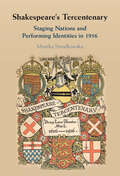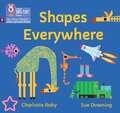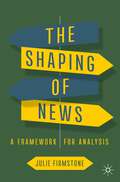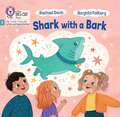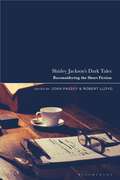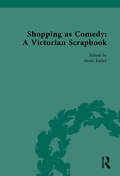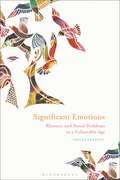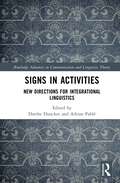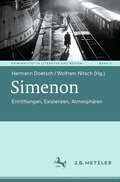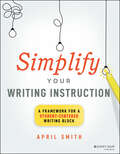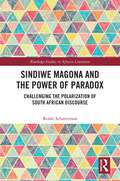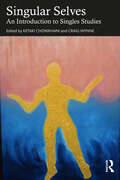- Table View
- List View
Shakespeare's Tercentenary: Staging Nations and Performing Identities in 1916
by null Monika SmialkowskaThe worldwide commemorations of the three-hundredth anniversary of Shakespeare's death were held amid the global upheaval of the First World War. As empires battled for world domination and nations sought self-determination, diverse communities vied to claim Shakespeare as their own, to underpin their sense of collective identity and cohesion. Unearthing previously unknown Tercentenary events in Europe, the British Empire, and the USA, Monika Smialkowska demonstrates that the 1916 Shakespeare commemorators did not speak with one unified voice. Tributes by marginalised social, ethnic, and racial groups often challenged the homogenising narratives of the official celebrations. Rather than the traditionally patriotic Bard, used to support totalising versions of national or imperial identity, this study reveals Shakespeare as a site of debate and contestation, in which diverse voices – local and global, nationalist and universalist, militant and pacifist – combined and clashed in a fascinating, open-ended dialogue.
Shakespeare’s Unmuted Women (Routledge Studies in Shakespeare)
by Gül KurtuluşShakespeare’s Unmuted Women explores women’s speeches in selected plays by Shakespeare, highlighting women’s discerning insight as a vital ingredient in these selected works. The book discusses the use of rhetoric in speeches by women as a cementing material that supports the casing of the incidents. Women holding forth on the issues related to the common concerns emerged in the plays perform a distinguishing role in strengthening the bond between decisions taken and executed by each character and make their major important contribution to the overall impact of the play. Comprising six chapters, the volume analyses Cordelia’s and Desdemona’s speeches in King Lear and Othello; Cleopatra’s and Tamora’s speeches in Antony and Cleopatra and Titus Andronicus; Beatrice’s and Rosalind’s speeches in Much Ado About Nothing and As You Like It; and Katherine’s and Lady Anne’s speeches in Henry V and Richard III, respectively. The text discusses women’s rich and profound discourse in these works to accentuate the meaningful input in verbal communication. In Shakespeare’s selected plays, women’s insightfulness and perspicuity are closely considered to emphasize how women make efficient use of rhetoric, aptly used by Queen Elizabeth I during Shakespeare’s time. Queen Elizabeth’s outstanding public speeches inspired those who listened to her and Shakespeare’s women are partial embodiments of her.
Shakespeare’s Unmuted Women (Routledge Studies in Shakespeare)
by Gül KurtuluşShakespeare’s Unmuted Women explores women’s speeches in selected plays by Shakespeare, highlighting women’s discerning insight as a vital ingredient in these selected works. The book discusses the use of rhetoric in speeches by women as a cementing material that supports the casing of the incidents. Women holding forth on the issues related to the common concerns emerged in the plays perform a distinguishing role in strengthening the bond between decisions taken and executed by each character and make their major important contribution to the overall impact of the play. Comprising six chapters, the volume analyses Cordelia’s and Desdemona’s speeches in King Lear and Othello; Cleopatra’s and Tamora’s speeches in Antony and Cleopatra and Titus Andronicus; Beatrice’s and Rosalind’s speeches in Much Ado About Nothing and As You Like It; and Katherine’s and Lady Anne’s speeches in Henry V and Richard III, respectively. The text discusses women’s rich and profound discourse in these works to accentuate the meaningful input in verbal communication. In Shakespeare’s selected plays, women’s insightfulness and perspicuity are closely considered to emphasize how women make efficient use of rhetoric, aptly used by Queen Elizabeth I during Shakespeare’s time. Queen Elizabeth’s outstanding public speeches inspired those who listened to her and Shakespeare’s women are partial embodiments of her.
The Shaping of News: A Framework for Analysis
by Julie FirmstoneThis book provides readers with the understanding required to analyse the range of key factors that shape the production of news, and to assess their implications for the role of news and journalism in democracy. It brings existing research together under the umbrella of a central organising framework to explore how news and its production is shaped by a multiplicity of factors including the norms, values, role perceptions and ethics associated with journalism as a profession, the role of news sources, the changing character and significance of news audiences, the aims and objectives of news organisations, and the political, economic and social contexts within which news is produced. Exploring these factors in depth, using examples, and considering the changing conditions of news production, the chapters chart significant changes, challenges, and responses to provide the essential background for understanding the consequences of current transformations for the democratic qualities of news.
Shaping the Sciences of the Ancient and Medieval World: Textual Criticism, Critical Editions and Translations of Scholarly Texts in History (Archimedes #69)
by Karine Chemla Agathe KellerThis book contributes to a worldwide history of textual criticism and critical editions of ancient scientific texts. It first looks at ancient editorial practices, and at their impact on modern editions. Contributions analyze how, through time, the perception of what a text was may have changed, and influenced how scholarly texts were made accessible. The second section looks at the historical, political and social contexts within which editions and translations of ancient scientific texts were produced. Finally, the last two parts examine the specificities of editions and translations that bore on scholarly documents. Not only is there a focus on how the elements specific to scientific texts—such as diagrams and numbers—were treated, but case studies analyzing the specific work carried out to edit mathematical and astronomical texts of the past are also offered to the reader. The scholarship displayed in this work lays the foundation for further studies on the history of critical editions and raises questions to those who make scholarly translations and critical editions today.
Shifting the Balance, Grades 3-5: 6 Ways to Bring the Science of Reading into the Upper Elementary Classroom
by Katie Cunningham Jan Burkins Kari YatesIn this much anticipated follow-up to their groundbreaking book, Shifting the Balance: 6 Ways to Bring the Science of Reading into the Balanced Literacy Classroom, authors Jan Burkins and Kari Yates, together with co-author Katie Cunningham, extend the conversation in Shifting the Balance, Grades 3-5: 6 Ways to Bring the Science of Reading into the Upper Elementary Classroom. This new text is built in mind specifically for grades 3-5 teachers around best practices for the intermediate classroom. Shifting the Balance, Grades 3-5 introduces six more shifts across individual chapters that: Zoom in on a common (but not-as helpful-as-we-had-hoped) practice to reconsider Untangle a number of “misunderstandings” that have likely contributed to the use of the common practice Propose a more science-aligned shift to the current practice Provide solid scientific research to support the revised practice Offer a collection of high-leverage, easy-to-implement instructional routines to support the shift to more brain-friendly instruction The authors offer a refreshing approach that is respectful, accessible, and practical – grounded in an earnest commitment to building a bridge between research and classroom practice. As with the first Shifting the Balance, they aim to keep students at the forefront of reading instruction.
Shifting the Balance, Grades 3-5: 6 Ways to Bring the Science of Reading into the Upper Elementary Classroom
by Katie Cunningham Jan Burkins Kari YatesIn this much anticipated follow-up to their groundbreaking book, Shifting the Balance: 6 Ways to Bring the Science of Reading into the Balanced Literacy Classroom, authors Jan Burkins and Kari Yates, together with co-author Katie Cunningham, extend the conversation in Shifting the Balance, Grades 3-5: 6 Ways to Bring the Science of Reading into the Upper Elementary Classroom. This new text is built in mind specifically for grades 3-5 teachers around best practices for the intermediate classroom. Shifting the Balance, Grades 3-5 introduces six more shifts across individual chapters that: Zoom in on a common (but not-as helpful-as-we-had-hoped) practice to reconsider Untangle a number of “misunderstandings” that have likely contributed to the use of the common practice Propose a more science-aligned shift to the current practice Provide solid scientific research to support the revised practice Offer a collection of high-leverage, easy-to-implement instructional routines to support the shift to more brain-friendly instruction The authors offer a refreshing approach that is respectful, accessible, and practical – grounded in an earnest commitment to building a bridge between research and classroom practice. As with the first Shifting the Balance, they aim to keep students at the forefront of reading instruction.
Shirley Jackson’s Dark Tales: Reconsidering the Short Fiction
by Joan Passey and Robert LloydThe first dedicated exploration of the short fiction of Shirley Jackson for three decades, this volume takes an in-depth look at the themes and legacies of her 200-plus short stories. Recognized as the mother of contemporary horror, scholars from across the globe, and from a range of different disciplinary backgrounds, dig into the lasting impact of her work in light of its increasing relevance to contemporary critical preoccupations and the re-release of Jackson's work in 2016. Offering new methodologies to study her work, this volume calls upon ideas of intertextuality, ecocriticism and psychoanalysis to examine a broad range of themes from national identity, race, gender and class to domesticity, the occult, selfhood and mental illness. With consideration of her blockbuster works alongside later works that received much less critical attention, Shirley Jackson's Dark Tales promises a rich and dynamic expansion on previous scholarship of Jackson's oeuvre, both bringing her writing into the contemporary conversation, and ensuring her place in the canon of Horror fiction.
Shopping as Comedy: A Victorian Scrapbook
by Alexis EasleyThis volume is a critical edition of a Victorian scrapbook, composed of cuttings from advertising images from the 1880's. These images are arranged in hand-drawn domestic spaces and embellished with watercolour details. At the foot of each page is a handwritten running text, written by an unknown Victorian author, that provides a narrative to explain the accompanying images. The album also includes four original short stories, interspersed by twenty-three vignettes, which, like advertisements in a magazine, echo and reinforce themes in the surrounding content. The album highlights issues of concern to women at the fin de siècle: romance, marriage, shopping, and house decoration. The satirical commentary on late Victorian shopping and commodity culture provides a fascinating insight into the interests and responses of consumers during this period. The volume will be of great interest to students and scholars of literary and advertising history.
Shopping as Comedy: A Victorian Scrapbook
This volume is a critical edition of a Victorian scrapbook, composed of cuttings from advertising images from the 1880's. These images are arranged in hand-drawn domestic spaces and embellished with watercolour details. At the foot of each page is a handwritten running text, written by an unknown Victorian author, that provides a narrative to explain the accompanying images. The album also includes four original short stories, interspersed by twenty-three vignettes, which, like advertisements in a magazine, echo and reinforce themes in the surrounding content. The album highlights issues of concern to women at the fin de siècle: romance, marriage, shopping, and house decoration. The satirical commentary on late Victorian shopping and commodity culture provides a fascinating insight into the interests and responses of consumers during this period. The volume will be of great interest to students and scholars of literary and advertising history.
Significant Emotions: Rhetoric and Social Problems in a Vulnerable Age
by Ashley FrawleySignificant Emotions is a piercing examination of the rising use of emotional signifiers in public debate and the rhetoric of an increasingly expansive array of social problems. Building on ideas developed in Ashley Frawley's previous book, Semiotics of Happiness, it examines in detail the 'emotional turn' across the social sciences and the broader cultural rise of the 'age of emotion' and its influence on how we talk about and approach new social issues. The book explores the rise of supposedly 'positive' emotional signifiers that have gained prominence as powerful causes of and solutions to nearly every social ill-from promoting self-esteem, happiness and mindfulness to concerns for well-being and mental health. Conceptualizing the rise and comparative decline of these emotional signifiers as cycles of discovery, adoption, expansion, and exhaustion, the book argues that rather than calling into question one or another of these signifiers, it is necessary to penetrate deeper to the underlying cultural currents that drive their adoption and contribute to their rhetorical power. Through a systematic and in-depth exploration of the appearance of these trends in a variety of claims-making activities across academia, traditional and social media, and social policy, Frawley argues that the 'age of emotion' does not represent a step toward a more enlightened and emotionally aware society. Rather, it signifies a preoccupation with emotional deficits and a firm belief that emotional disorientation ultimately underlies nearly every social ill. Emerging from the analysis is the conclusion that emotions have become key signifiers of broader cultural tendencies to affirm conservatism over progress, vulnerability over resilience, and the determined self over the free willing subject.
Signs in Activities: New Directions for Integrational Linguistics (Routledge Advances in Communication and Linguistic Theory)
by Dorthe Duncker Adrian PabléThis book is a collective volume bringing together scholars who share an interest in linguistics from an integrational point of view and in developing new directions for future scholarship.Integrational linguistics invites us to rethink the theoretical and methodological premises of general linguistics by drawing on a different conception of the sign and by recognizing the creativity that human communication requires. Some chapters are concerned with concepts like the sign, contextualization, activity, and integration. Although being core concepts developed by the founder of integrational linguistics, Roy Harris, they have arguably remained underdeveloped in Harris’ writings and thus call for further clarification and investigation. Other chapters are concerned with the notions of the self and the social, experience and interaction, with questions about individual agency and will, and human sociality and social organization, which all occupy a central position in integrational theory. Finally, remaining chapters focus on how scriptism and the language myth have influenced our way of thinking about communication in a broad sense.This edited collection will be of interest to a multidisciplinary readership comprising those engaged in study, teaching, and research in the humanities and social sciences, including anthropology, the arts, education, linguistics, literary studies, philosophy, psychology, and semiotics.
Signs in Activities: New Directions for Integrational Linguistics (Routledge Advances in Communication and Linguistic Theory)
This book is a collective volume bringing together scholars who share an interest in linguistics from an integrational point of view and in developing new directions for future scholarship.Integrational linguistics invites us to rethink the theoretical and methodological premises of general linguistics by drawing on a different conception of the sign and by recognizing the creativity that human communication requires. Some chapters are concerned with concepts like the sign, contextualization, activity, and integration. Although being core concepts developed by the founder of integrational linguistics, Roy Harris, they have arguably remained underdeveloped in Harris’ writings and thus call for further clarification and investigation. Other chapters are concerned with the notions of the self and the social, experience and interaction, with questions about individual agency and will, and human sociality and social organization, which all occupy a central position in integrational theory. Finally, remaining chapters focus on how scriptism and the language myth have influenced our way of thinking about communication in a broad sense.This edited collection will be of interest to a multidisciplinary readership comprising those engaged in study, teaching, and research in the humanities and social sciences, including anthropology, the arts, education, linguistics, literary studies, philosophy, psychology, and semiotics.
Silent Film and the Formations of U.S. Literary Culture: Literature in Motion
by Sarah Gleeson-WhiteSilent Film and the Formations of U.S. Literary Culture: Literature in Motion argues that the emergence of motion pictures constituted a defining moment in U.S. literary history. Author Sarah Gleeson-White discovers what happened to literary culture-both popular and higher-brow?when inserted into the spectacular world of motion pictures during the early decades of the twentieth century. How did literary culture respond to, and how was it altered by, the development of motion pictures, literature's exemplar and rival in narrative realism and enthrallment? Gleeson-White draws on extensive archival film and literary materials, and unearths a range of collaborative, cross-media expressive and industrial practices to reveal the manifold ways in which early-twentieth-century literary culture sought both to harness and temper the reach of motion pictures.
Simenon: Ermittlungen, Existenzen, Atmosphären (Kriminalität in Literatur und Medien #5)
by Hermann Doetsch Wolfram NitschDieser Band würdigt Simenons lange unterschätztes Romanwerk in vierfacher Hinsicht. In gattungsgeschichtlicher Perspektive arbeitet er die Originalität der Ermittlerfigur Maigret sowie die Affinität der „harten Romane“ zum Existentialismus heraus. Unter subjektgeschichtlichem Aspekt legt er dar, wie die Protagonisten gerade dieser Romane mit Prozessen sozialer Modernisierung und biopolitischer Kontrolle in Konflikt geraten. In medientheoretischer Hinsicht wird beleuchtet, wie genau Simenon moderne Techniken der Untersuchung und der Überwachung beobachtet hat. Unter raumtheoretischem Gesichtspunkt schließlich behandelt er seinen ausgeprägten Sinn für Milieus und Atmosphären.
Simplify Your Writing Instruction: A Framework For A Student-Centered Writing Block
by April SmithSet up your writing block quickly and easily with a simple, research-based framework Schools need their writing instruction simplified. Most classrooms share writing time with another subject, making it difficult for students to receive the direct writing instruction they need. Between the lack of time, increased gaps in writing skills, and inconsistent writing curriculum, teachers are struggling to bring their students up to grade level. Simplify Your Writing Instruction provides you with a classroom-tested framework that helps you set up your writing block within the limited time and resources you have. Step by step, this practical guide shows you how to amplify your students’ writing skills, employ simple feedback opportunities and interventions, streamline your lessons, use simple differentiation techniques to help reach students of all ability levels, and more. Author April Smith is a former teacher who has trained more than 50,000 K-12 educators on best practices for writing instruction. While in the classroom, she learned that having simple and consistent systems in place is critical. Accordingly, none of the tasks and strategies will require you to create or prep anything complicated or time-consuming. In Simplify Your Writing Instruction, you will find easy-to-use checklists, implementation tasks, customizable templates, student writing samples, helpful tables and charts, and a simple spreadsheet that you can use to plan your lessons and modify your teaching to meet the needs of each writer. Be confident and supported in your writing instruction. Simplify Your Writing Instruction will teach you how to: Implement the Simple Pre-Assessment Process in your classroom Encourage authentic writing practice at home Differentiate your lessons to reach your Special Education, ELL, and Gifted students Integrate grammar naturally and optimize student output after each lesson Split the writing process into efficient and effective 10- to 15-minute mini-lessons Make writing a priority by incorporating writing application into other subjects Use a simple pre-assessment to get a better overall picture of what your students can do Utilize more complex strategies such as small group work and conferring Packed with expert advice and easy-to-follow strategies, Simplify Your Writing Instruction: A Framework for a Better Writing Block is a must-have resource for all K-12 educators and teachers in training.
Simplify Your Writing Instruction: A Framework For A Student-Centered Writing Block
by April SmithSet up your writing block quickly and easily with a simple, research-based framework Schools need their writing instruction simplified. Most classrooms share writing time with another subject, making it difficult for students to receive the direct writing instruction they need. Between the lack of time, increased gaps in writing skills, and inconsistent writing curriculum, teachers are struggling to bring their students up to grade level. Simplify Your Writing Instruction provides you with a classroom-tested framework that helps you set up your writing block within the limited time and resources you have. Step by step, this practical guide shows you how to amplify your students’ writing skills, employ simple feedback opportunities and interventions, streamline your lessons, use simple differentiation techniques to help reach students of all ability levels, and more. Author April Smith is a former teacher who has trained more than 50,000 K-12 educators on best practices for writing instruction. While in the classroom, she learned that having simple and consistent systems in place is critical. Accordingly, none of the tasks and strategies will require you to create or prep anything complicated or time-consuming. In Simplify Your Writing Instruction, you will find easy-to-use checklists, implementation tasks, customizable templates, student writing samples, helpful tables and charts, and a simple spreadsheet that you can use to plan your lessons and modify your teaching to meet the needs of each writer. Be confident and supported in your writing instruction. Simplify Your Writing Instruction will teach you how to: Implement the Simple Pre-Assessment Process in your classroom Encourage authentic writing practice at home Differentiate your lessons to reach your Special Education, ELL, and Gifted students Integrate grammar naturally and optimize student output after each lesson Split the writing process into efficient and effective 10- to 15-minute mini-lessons Make writing a priority by incorporating writing application into other subjects Use a simple pre-assessment to get a better overall picture of what your students can do Utilize more complex strategies such as small group work and conferring Packed with expert advice and easy-to-follow strategies, Simplify Your Writing Instruction: A Framework for a Better Writing Block is a must-have resource for all K-12 educators and teachers in training.
Sindiwe Magona and the Power of Paradox: Challenging the Polarization of South African Discourse (Routledge Studies in African Literature)
by Renée SchattemanThis book examines the work of Sindiwe Magona, one of South Africa’s most prolific and groundbreaking writers, widely recognized for highlighting the everyday experiences of women and the domestic side of apartheid. A pioneer among black African women writers, she is equally respected as storyteller, advocate for children’s education, activist for HIV/AIDS awareness, and champion of indigenous languages. In this book, Renée Schatteman contends that Magona’s most important contribution comes through her refusal to choose sides in the contentious debates that have polarized public discourse following apartheid. By straddling two (or more) sides of a controversy and challenging any who do harm to others (and to the nation), regardless of their position, she blurs distinctions that are assumed to be absolute, opens new avenues of understanding, and inspires alternative visions for the future. By occupying the space of paradox, she undermines the closed epistemological structures inherited from apartheid and champions the need for interdependence, truth-telling, and dialogue. Covering her creative production over three decades (which includes novels, autobiographies and biographies, short story collections, children’s books, and literature about HIV/AIDS), this book is an essential read for Magona enthusiasts as well as for researchers of African literature and postcolonial South Africa.
Sindiwe Magona and the Power of Paradox: Challenging the Polarization of South African Discourse (Routledge Studies in African Literature)
by Renée SchattemanThis book examines the work of Sindiwe Magona, one of South Africa’s most prolific and groundbreaking writers, widely recognized for highlighting the everyday experiences of women and the domestic side of apartheid. A pioneer among black African women writers, she is equally respected as storyteller, advocate for children’s education, activist for HIV/AIDS awareness, and champion of indigenous languages. In this book, Renée Schatteman contends that Magona’s most important contribution comes through her refusal to choose sides in the contentious debates that have polarized public discourse following apartheid. By straddling two (or more) sides of a controversy and challenging any who do harm to others (and to the nation), regardless of their position, she blurs distinctions that are assumed to be absolute, opens new avenues of understanding, and inspires alternative visions for the future. By occupying the space of paradox, she undermines the closed epistemological structures inherited from apartheid and champions the need for interdependence, truth-telling, and dialogue. Covering her creative production over three decades (which includes novels, autobiographies and biographies, short story collections, children’s books, and literature about HIV/AIDS), this book is an essential read for Magona enthusiasts as well as for researchers of African literature and postcolonial South Africa.
Singular Selves: An Introduction to Singles Studies
by Ketaki Chowkhani and Craig WynneThis book examines, for perhaps the first time, singlehood at the intersections of race, media, language, culture, literature, space, health, and life satisfaction. It adopts an interdisciplinary approach, borrowing from sociology, literary studies, medical humanities, race studies, linguistics, demographic studies, and critical geography to understand singlehood in the world today. This collection of essays aims to establish the discipline of Singles Studies, finding new ways of examining it from various disciplinary and cultural perspectives. It begins with laying the field and then moves on to critically look at how race has shaped the way we understand singlehood in the West and how class, age, gender, privilege, and the media play a role in shaping singlehood. It argues for a need for increased interdisciplinarity within the field, for example, analyzing singlehood from the perspective of medical humanities. The volume also explores the role workplace, living arrangements, financial status, and gender play in single people’s life satisfaction. With an interdisciplinary and transnational approach, this interdisciplinary volume seeks to establish Singles Studies as a truly global discipline. This pathbreaking volume would be of interest to students and researchers of sociology, literature, linguistics, media studies, and psychology.
Singular Selves: An Introduction to Singles Studies
by Ketaki Chowkhani Craig WynneThis book examines, for perhaps the first time, singlehood at the intersections of race, media, language, culture, literature, space, health, and life satisfaction. It adopts an interdisciplinary approach, borrowing from sociology, literary studies, medical humanities, race studies, linguistics, demographic studies, and critical geography to understand singlehood in the world today. This collection of essays aims to establish the discipline of Singles Studies, finding new ways of examining it from various disciplinary and cultural perspectives. It begins with laying the field and then moves on to critically look at how race has shaped the way we understand singlehood in the West and how class, age, gender, privilege, and the media play a role in shaping singlehood. It argues for a need for increased interdisciplinarity within the field, for example, analyzing singlehood from the perspective of medical humanities. The volume also explores the role workplace, living arrangements, financial status, and gender play in single people’s life satisfaction. With an interdisciplinary and transnational approach, this interdisciplinary volume seeks to establish Singles Studies as a truly global discipline. This pathbreaking volume would be of interest to students and researchers of sociology, literature, linguistics, media studies, and psychology.
Sinn in der Klimakrise: Über eine planetare Literaturtheorie (Literary Ecologies #5)
by Simon ProbstIm Kontext der Klimakrise erscheint Sinn nicht mehr als isoliertes Phänomen menschlicher Kultur, sondern eingebettet in das Leben auf der Erde. Daraus ergeben sich neue Fragen an der Schnittstelle von Semiotik, Literatur- sowie Kulturwissenschaft: Welche Rolle spielen Zeichen für unseren Planeten? Wie ist die kulturelle Sinnproduktion in das Erdsystem eingebunden? Und wie lesen wir Klassiker der Literaturgeschichte im planetaren Kontext als Teil einer Geschichte des Anthropozäns? Simon Probst entwirft kulturtheoretische Perspektiven auf Klimaforschung. Er erkundet Literatur im Lichte unseres Planeten und umgekehrt. So entsteht nicht zuletzt eine eindrückliche Darstellung davon, wie Literatur unseren Blick auf die Erde verändert.
Sir Philip Sidney: The New Arcadia, Second Revised Edition (The Manchester Spenser)
by J. B. Lethbridge Elisabeth Chaghafi Victor SkretkowiczModern readers mostly know Sir Philip Sidney’s Arcadia in its complete ‘old’ version, but it is the New Arcadia (published in 1590), a revised version of his pastoral romance The Countess of Pembroke’s Arcadia, that was the most influential and most widely imitated literary text of the sixteenth century. Preserving the basic plot, New Arcadia adds further narrative strands and introduces ambitious revisions, demonstrating Sidney’s brilliance as a prose writer.This edition of the New Arcadia is the first in nearly four decades, preserving the text of Victor Skretkowicz’ celebrated 1987 edition, whilst making the text accessible through modern spelling and supplementing it with a substantially expanded scholarly commentary, an updated glossary, and additional long notes on the book’s history and Sidney’s use of rhetorical devices, as well as his contributions to the English language.
